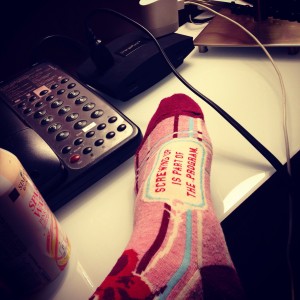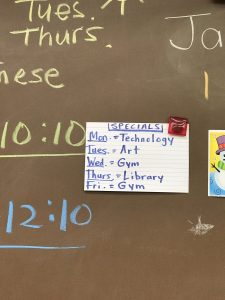 I obviously made that number up, but why not? In the social sciences, we manipulate numbers all the time. Why should I be different? During my last formal year teaching, my Principal gave two benchmark tests — AIMSwebTM and MAPTM — so she could give her best numbers to the state. The other numbers got buried upstairs in the coaches room, I imagine. I loved that newspaper article from a few years back where the federal government claimed their financial infusions had saved the jobs of 473 of our district teachers — an amazing feat in a district that had only 290 teachers.
I obviously made that number up, but why not? In the social sciences, we manipulate numbers all the time. Why should I be different? During my last formal year teaching, my Principal gave two benchmark tests — AIMSwebTM and MAPTM — so she could give her best numbers to the state. The other numbers got buried upstairs in the coaches room, I imagine. I loved that newspaper article from a few years back where the federal government claimed their financial infusions had saved the jobs of 473 of our district teachers — an amazing feat in a district that had only 290 teachers.
But let’s forget mystery numbers for the moment. I am going after a mystery idea, the blank slate theory, and I expect to venture into politically incorrect territory. The blank slate, or tabula rasa, view of human development is generally believed to have originated with John Locke. According to the blank slate theory, a child develops into the person he or she will become purely as a result of environmental effects, the writing upon the slate of that new person.
Neuroscience has repeatedly debunked this idea. Studies of twins separated at birth provide immediate sets of inexplicable counterexamples. In one study, researchers photographed twins, and quirkily found that identical twins stood the same way, while fraternal twins adopted different postures. The effect of genes on emotional and mental processing has been well-documented. But fans of the blank slate remain vocal forces in education. Why?
Questions I have posed to friends when discussing the blank slate theory: Who are these people? Who are these people who believe that all humans represent equal bundles of potential? How does one become an adult while holding onto this idea? I would think cat ownership would be enough to debunk the concept. But blank slate believers come back hard and fast, observing that even cats who live in the same house do not share identical environments. They are right, but this fact does not explain why Tom can be taught not to climb the curtains and Fluffy can’t.
I had a few insights yesterday while reading The Blank Slate: The Modern Denial of Human Nature by Steven Pinker, who takes on Locke’s noble and hopeful view of human capacity. I recommend the book. It’s a fun, scholarly read covering many topics related to human potential.
Here’s where I think Pinker helped me to understand the slate theorists:
Pinker believes our anxiety about innate human differences results from four fears:
1. Discrimination and even oppression might be justifiable if humans were innately different. (Slavery might be justifiable.)
2. If morality is not taught, but is inborn, then we cannot rely on our ability to improve the human condition. (Our Ted Bundy’s cannot be fixed.)
3. If biology determines people’s personality and behavior, they implicitly lack free will. We cannot then consider them responsible for their actions. (Ted was insane. It was not his fault. He had no choice.)
4. If we are mere products of our genes, then perhaps life has no noble purpose, no higher meaning. (We are doomed to battle our Teds to no good purpose.)
Eduhonesty: The desire to believe that our children can be whatever we shape them to be has real appeal. But zero evidence supports this view. The evidence runs strongly in the other direction. Despite NCLB’s Draconian penalties for not getting all special education students up to “grade level” by the year 2014, the percentage of special education students who made it to grade level by 2014 did not differ appreciably from the percentage who made that climb in 2003, the first year of NCLB. We lost the NCLB fight, no matter how educational leaders may spin the facts.
We are not powerless. When we put three-year-old, autistic children into public preschools, we are acknowledging that early interventions can help children become more functional and better prepared for later life. We know that supportive teachers can make an amazing difference in the lives of lost and lonely students. We know that a child’s slate can be written and rewritten, many times in many different ways.
But we do ourselves and, more importantly, our children no favors when we try to support the blank slate theory indiscriminately. We trap ourselves then into the view often expressed in the words: You can do it. You just need to try harder.
No, no, no, no, no. Maybe she can’t do it. Maybe he simply does not have an ear for music. Dyslexia is real. Lack of mathematical aptitude is real. Tone deafness is real. The effects of years of poor attendance are real. Crippling ADHD is real. I’d even go so far as to say that laziness is real. Yes, we can work to motivate students. We can send home daily logs to their parents. We can encourage them, come up with all sorts of strategies to engage those children in school. But, frankly, some kids make an art form of laziness, especially by high school. That tabula’s not rasa — it’s just in sleep mode.
The problem with “You can do it!” comes when a child CANNOT do “it.” We make that child feel stupid. We make that child feel sad. We make that child feel deficient. We make that child feel hopeless. Our students and children don’t want to disappoint us. “You can do it!” sets them up, though. They try and try, and then realize that despite all their efforts, they are going disappoint us anyway.
No slate will ever be blank. Our job as educators should be to find out how to best help each child make the best of his or her potential. To do this, we must acknowledge those varying potentials — the writing already on the slate.
“You can be whatever you want to be” is a lie. And if we think those lies are harmless, we should pause to consider America’s college dropouts who owe $10,000, $20,000 or even $50,000 or more in loans. A lie with good intentions remains a lie, and our kids are the ones who will pay for those lies.

